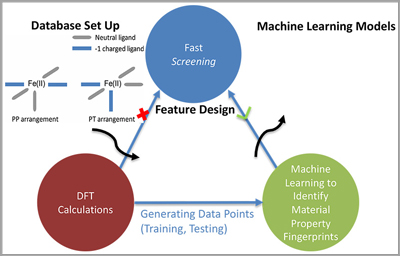GEAR Program Focus On Dr. Rachel Getman
Computationally Driven Design of Substituted Metal Ferrite Materials
 Substituted metal ferrite materials have the chemical formula MxFe(3 – x)O4, where M stands for metal (M = Mn, Co, Ni, or Cu), and crystalize in the inverse spinel structure. These materials have tailorable magnetic properties, which are determined in part by their compositions. We are specifically interested in these materials’ magnetic moments, which describe their magnetic strengths, and their magnetic anisotropies, which describe how their magnetic moments propagate along their different crystallographic directions. We are interested in these properties because they control the energies that can be dissipated by the materials, which is important in many fields, having applications in biomedicine, devices, and other fields. In this work, our goal is to learn how to control the magnetic properties of substituted metal ferrites by varying their compositions. To do this, we are using solid state quantum chemical calculations to compute the magnetic properties of hundreds of substituted metal ferrite materials, and machine learning to identify the link between composition and magnetic properties. In order to develop a predictive model that can be used to quickly screen materials for desired magnetic properties, we are using tabulated properties such as electronegativity, ionization potential, and electron configuration as inputs to the machine learning models. The machine learning models develop correlations between these properties and the magnetic properties of the materials. So far, we have been able to identify a correlation that predicts the magnetic moments of substituted metal ferrites to within a root mean squared error (RMSE) of 0.6 Bohr magnetons. Our next steps are to improve the correlations so that they exhibit a RMSE of below 0.2 Bohr magnetons, and then to perform the analogous analysis for magnetic anisotropy. Seed funding through the GEAR Program was integral to the immense success that we’ve had in this project so far, providing funding for both a computational graduate student and an experimental students, who are working together to learn how to design substituted metal ferrites with tailored properties.
Substituted metal ferrite materials have the chemical formula MxFe(3 – x)O4, where M stands for metal (M = Mn, Co, Ni, or Cu), and crystalize in the inverse spinel structure. These materials have tailorable magnetic properties, which are determined in part by their compositions. We are specifically interested in these materials’ magnetic moments, which describe their magnetic strengths, and their magnetic anisotropies, which describe how their magnetic moments propagate along their different crystallographic directions. We are interested in these properties because they control the energies that can be dissipated by the materials, which is important in many fields, having applications in biomedicine, devices, and other fields. In this work, our goal is to learn how to control the magnetic properties of substituted metal ferrites by varying their compositions. To do this, we are using solid state quantum chemical calculations to compute the magnetic properties of hundreds of substituted metal ferrite materials, and machine learning to identify the link between composition and magnetic properties. In order to develop a predictive model that can be used to quickly screen materials for desired magnetic properties, we are using tabulated properties such as electronegativity, ionization potential, and electron configuration as inputs to the machine learning models. The machine learning models develop correlations between these properties and the magnetic properties of the materials. So far, we have been able to identify a correlation that predicts the magnetic moments of substituted metal ferrites to within a root mean squared error (RMSE) of 0.6 Bohr magnetons. Our next steps are to improve the correlations so that they exhibit a RMSE of below 0.2 Bohr magnetons, and then to perform the analogous analysis for magnetic anisotropy. Seed funding through the GEAR Program was integral to the immense success that we’ve had in this project so far, providing funding for both a computational graduate student and an experimental students, who are working together to learn how to design substituted metal ferrites with tailored properties.
Return to GEAR and GEAR CRP Focus On Overview
